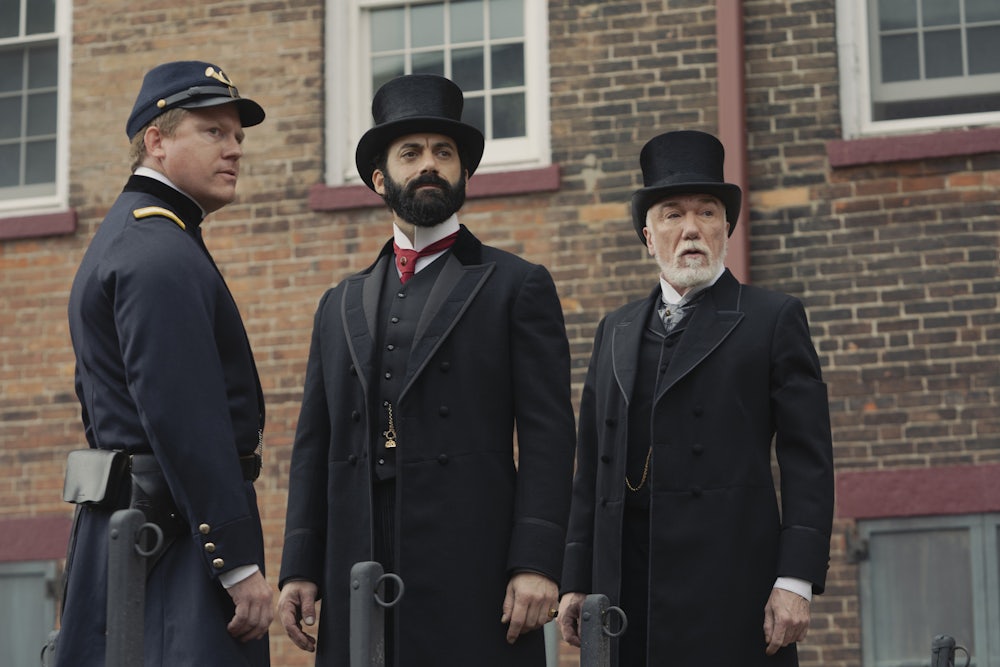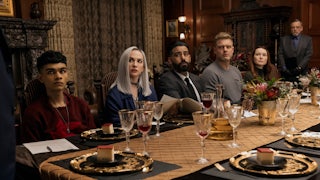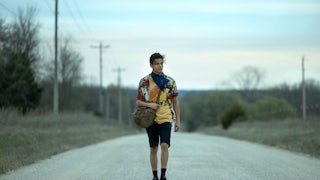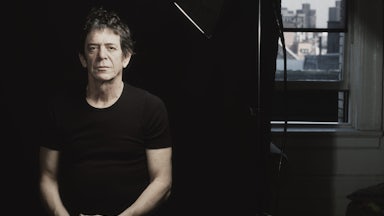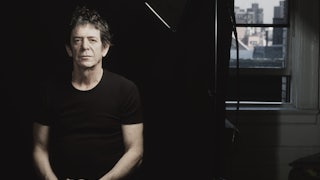Looking back, labor unions were strangely central to a lot of the earliest hits of HBO’s prestige era. Corrupt union politics and all those “no show” construction jobs serve as an ambient background for many of The Sopranos’ plotlines; The Wire devoted its entire second season to the Shakespearean tragedy of Frank Sobotka and the International Brotherhood of Stevedores; Deadwood’s microcosmic American origin story was haunted, through its entire run, by the looming threat of brutal, strike-breaking Pinkertons, snuffing out the prospect of organized labor in its messy infancy. The antiheroes Brett Martin has called the “difficult men” of this TV era were all also, in vexed and complicated ways, union men.
This cluster of labor plots at the turn of the twenty-first century seems all the more unusual given how little unions have played into subsequent TV series. Workplace comedies have abounded, melodramas of obscene wealth litter the television landscape, and cop stories thrive in every genre, but rarely do these series choose to foreground the union politics that certainly exist, if off-screen, in their story-worlds. NBC’s beloved Superstore and HBO’s The Plot Against America featured union storylines, and Kendall Roy dispatched with Vaulter once its staff got organized in season 1, but these are largely exceptions to the rule. The Bear has yet to raise the specter of unionization in its family kitchen, and even Abbott Elementary, which goes out of its way to advocate for undervalued, underserved teachers, seldom invokes the teachers’ union as an ally in that campaign.
In a moment defined by the Writers Guild of America’s recent victory and the actors’ union SAG-AFTRA’s ongoing battle with the Alliance of Motion Picture and Television Producers, it’s conspicuous that so few series even try to represent labor struggles like those of the dues-paying, picketing union members that staff their writers’ rooms and fill their screens. Unions are fighting for screen artists behind the camera; in front of the camera, they’re all but invisible.
If you’ve been wishing for a change in this status quo, for a long-awaited return of the labor struggle to prestige TV screens, then you might want to reconsider whatever monkey’s paw you’ve been using, because unions are back on HBO, but it’s British bourgeois bard Julian Fellowes who’s granting your wish. This week, as the AMPTP and SAG-AFTRA remain locked in tense negotiations, The Gilded Age—a show about the innate humanity and erotic magnetism of nineteenth-century robber barons—has decided it has a story to tell about organized labor.
When The Gilded Age debuted last year on HBO, it immediately invited comparisons to great works of turn-of-the-century realist fiction. The show’s plots—especially those focused on the rising and falling fortunes of naïve and ambitious women in Manhattan’s marriage markets—called to mind classic novels by Edith Wharton and Henry James. And the grand costumes, Beaux Arts architecture, and bare-knuckle social combat flooding every frame evoked great screen adaptations of those Gilded Age New York tales by Martin Scorsese and the late Terence Davies. But the comparisons ended there. Rather than a playfully anachronistic fan-fic treatment of those novels in the style of Bridgerton’s Austen cosplay, The Gilded Age felt more like a boosterish bowdlerization. Nobody ever really falls, no secret desires ever remain tragically unspoken, everybody wins a bit, and nobody loses anything they can’t do without.
The first season of The Gilded Age, despite all this, was a moderate success. I was disappointed that the show didn’t lean into a Whartonian level of glamour and dread, but I think I’m among a minority of viewers whose frustration lasted more than a few episodes. The show, even at its worst, is compulsively watchable. Like The Good Wife before it, The Gilded Age is a veritable who’s who of great New York theater actors: Tony nominees in bustles and cravats as far as the eye can see. Every image is stuffed to bursting with voluptuous scenery and densely populated with stage and screen legends to chew it. There’s Christine Baranski doing her best American Maggie Smith impersonation as the widowed figurehead of an old-money Manhattan family; Carrie Coon and Morgan Spector as fearsome, ferociously sexy industrialist strivers; Cynthia Nixon as a meek spinster; Michael Cerveris as a valet with a scandalous secret; Audra McDonald as the middle-class mother of Denee Benton’s aspiring Black press journalist; Laura Benanti as a horny Newport widow; and even Nathan Lane, doing a baffling take on Foghorn Leghorn as the social consigliere to Mary Astor. You could do a whole lot worse than watching this cast of worthies preen their way through a series of low-stakes social snafus.
The show’s second season doesn’t just continue to coast on these hammy, occasionally moving performances. It’s also showing the self-awareness to transform itself a little. The first season centered around Louisa Jacobson’s Marian Brook—an impoverished Pennsylvania cousin of the illustrious Van Rijn family, who moves to New York to live with her wealthy, estranged aunts after the death of her father. Her need to be educated in the ways of high society provided a useful vehicle for long scenes of unobtrusive exposition. But, especially among towering screen presences like Baranski and Coon, Jacobson’s performance struggled to command the camera’s attention, and the focus on her relatively wan narrative often dissipated any energy the show managed to generate in its other plotlines.
The second season has corrected this by shifting to a much more egalitarian ensemble model with formidable socialite Bertha Russell (Carrie Coon) as the gravitational center. Coon remains one of the great TV actors of her generation, and she manages to turn a frothy subplot—about the rivalry between the Academy of Music and the new Metropolitan Opera House—into genuinely gripping drama. The Gilded Age’s investment in reconstructing “The Opera War” is part of a larger emphasis, this season, on the procedural. Many of the new season’s most compelling subplots share a focus on small-bore logistics, whether it’s the details of financing the Met, the process of applying for a federal patent for a new alarm clock, or even the design and construction of the Brooklyn Bridge. If the second season has taken anything from realists like Wharton and James, it’s the idea that these stories live and breathe through their attention to detail. While the new season retains the original’s predilection for sloppy opulence and bland generality, there are enough finely tuned and observed subplots to make the whole thing run a little more smoothly this time.
Many of the realists whose novels are being interpolated by this show, though, were obsessed with the present. They insisted on describing, and thus stabilizing, a vision of the contemporary moment. James, for instance, writing to his peer Sarah Orne Jewett, said, “The ‘historic” novel is, for me, condemned … to a fatal cheapness.… You may multiply the little facts that can be got from pictures & documents, relics & prints, as much as you like—the real thing is almost impossible to do.” The irony of The Gilded Age, then, is of a series clothed in the stylistic garb of the realist novel, embarking upon a task that the Gilded Age high realists might have found fatally cheap.
And you can see their point! For every closet drama between cousins that unfolds on the show, we have a lurchingly awkward visit to the park where—did you know?—the torch of the Statue of Liberty was displayed during construction or a brief pop-in from an absolutely swag-less Oscar Wilde or a visit to the real architect—a LADY, if you can imagine!—of the Brooklyn Bridge. A subplot about a visit to Booker T. Washington’s Tuskegee Institute and an attempted lynching, for instance, represents an almost offensively laughable error. The specter of racial violence becomes window-dressing for a series that is, on principle, uninterested in the messier aspects of the history it represents. The show’s brief toe-dip into the Jim Crow South is rendered even more ridiculous when the story of a narrowly averted lynching is intercut with the story of the Russells’ butler narrowly averting a situation in which the Duke of Buckingham would be served a bowl of bad-tasting soup. The Gilded Age isn’t about the present, but it is surely presentist in its touristic interest in the historical highlights of the time. Nowhere is this clearer than in this season’s showdown between railway magnate George Russell (Morgan Spector) and the steelworkers’ union of Pittsburgh.
There’s almost no way that The Gilded Age could have anticipated that this new season would air shortly after the resolution of a major WGA strike and in the midst of ongoing negotiations to end the SAG-AFTRA strike. But the parallels between the show’s labor plotline and the labor plotline in which all of its cast members are currently embroiled are too neat to ignore. At the start of this new season, the Russells are dealing with two problems. The first is that Bertha Russell is leading the charge to establish, and legitimize, the Metropolitan Opera company in New York. The second is that George Russell is trying to resist the pressure of trade unionists organized at his mills in Western Pennsylvania. The Russells are both patrons of the arts and wealthy executives beset by labor actions. All that the protagonists of The Gilded Age want is to fund and produce prestige entertainment without being bothered by the annoyance of striking workers! When David Zaslav watched these screeners, he must have wondered if the show was a roman à clef.
Morgan Spector is one of the revelations of this show, at least in part because he somehow imbues a part that could credibly be played by the Monopoly Man with a discordant warmth and humanity to match his lethal guile. (Whether the show should give such a generous edit to such a character is a different question.) Russell represents a cartoon version of a Gilded Age robber baron, both in his laughably broad characterization and in his almost cuddly fatherly energy. While Russell is put at odds with Henderson (Darren Goldstein), the fiery and ethical union leader at his steel mill, the show has worked hard to train us to believe that Russell will resist the impulse of nearly every historical figure upon which he is based and do the right thing, or at least some approximate version of it. When Henderson asks Russell, “Do you believe that workers can win against capital?” you can tell that somewhere, some part of Russell is thinking, “Well, yeah, maybe!”
Andrew Carnegie would not have been so persuaded. In 1892, during the labor action The Gilded Age seems to be drawing on for inspiration, striking laborers at Homestead Steel Works in Pittsburgh fought and defeated Pinkerton agents employed by Carnegie and Henry Clay Frick. Seven workers died, and, despite that victory, the strike was ultimately broken. Real-life magnates like Carnegie and Frick weren’t half as sympathetic as George Russell. But it should not be much of a spoiler to say that what ends up happening with Russell and his workers does not quite hew to that cruel historical line. In Fellowes’s alternate history, the bad guys whose badness is the defining feature of their era are, counterintuitively, counterfactually, not so bad once you get to know them.
The Gilded Age has never been trying to do too much. Two seasons in, it’s content being a bit of floofy, indulgent period drama fun. And, in that respect, it’s never been better. But the predicament is that The Gilded Age also insists on periodically picking up complex histories and treating them with the same lightness, frivolity, and blinkered optimism with which it treats the romantic prospects of the leads. As one of the only contemporary representations of a labor union to appear in TV’s season of solidarity, it feels odd that our favorite robber baron would be presented to viewers as a reasonable family man, wary of the markets but ultimately sensitive to the plight of their workers. TV writers and actors are not in the same dire straits as the steelworkers of Homestead, but network and studio executives have authorized the same starvation tactics and public smears their Gilded Age ancestors used to avoid paying too far above “the going rate.”
At one point in the new season, frustrated by a stymied negotiation with the union rep, Russell cries aloud, “Why must I be the villain in every story?” The irony, which may well be lost on Fellowes, is that George has never been the villain of this story. In fact, The Gilded Age has to send George to Pittsburgh to meet Henderson’s cute little family in their domestic squalor in order to generate some sympathy for the union itself. Sometime soon, Fran Drescher will return to negotiating with a conference table full of TV and film executives like David Zaslav. The Gilded Age doesn’t have a lot to tell us about how that might unfold or what the contemporary labor movement has to learn from the strikers at Homestead or why solidarity is even an important aim. It does want us to know, though, that all of those executives gathered together, those titans of industry and patrons of the arts, certainly don’t believe that they are the bad guys. And, ultimately, that’s good to know.
